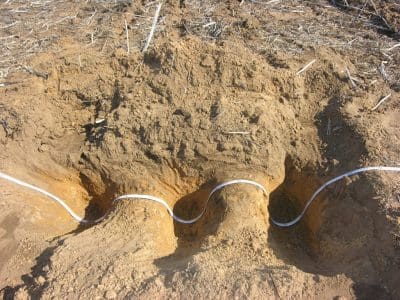GRAIN growers in Western Australia looking to take advantage of recent rainfall and start deep ripping paddocks are being warned their soils may still be too wet and they may do more harm than good.

An example of the ideal V shape produced from deep ripping sandy loam soils. DAFWA warns if a Y shape is formed, soils are still too wet to renovate, which could result in yield penalties.
Department of Agriculture and Food (DAFWA) research officer Wayne Parker encouraged landholders to examine soils throughout their paddocks thoroughly before dragging out the deep ripper.
Mr Parker said if the soil profile was too wet, machinery tynes would move through the soil ‘like a knife through butter’, producing no soil renovation benefit.
“If the soil profile is too wet it is not going to lift and shatter properly to loosen the whole soil profile, and is more likely to smear instead,” he said.
“If deep ripping isn’t done properly, it is not only a waste of time and money, it could have a negative effect on crop yields. There is the potential to compact the soil during the ripping process, reducing root growth and access to soil moisture during the season.”
Deep ripping the top 35-50 centimetres of topsoil is typically undertaken to loosen hard layers of loamy sands to allow plant roots to access subsoil moisture, resulting in yield benefits that can last longer than two seasons, particularly when used in conjunction with controlled traffic farming.
Mr Parker said there was a simple way to evaluate whether soils were still too wet for deep ripping.
“Growers would be wise to get out in their paddocks, sample the soil at the depth to be ripped, and roll a handful of soil into a three millimetre diameter thin sausage to test the cohesion of the soil,” he said.
“If you can roll the soil into a thin sausage and it maintains its shape, the clay-held moisture in the soil indicates it is too wet to rip. Soils in this state will smear along the ripping line, making a hostile zone for root growth.”
Another option is to rip a strip of a paddock and dig a hole behind the furrow rip to examine the breakout profile of the soil.
“The required shape is a V from the bottom to top of the ripping tine,” Mr Parker said.
“If the hole takes a Y shape, the soil is shattering from further up the tine and not the point. This creates horizontal compaction on the sides of the tine, damaging the soil profile and making it hard for roots to get through that lower section of the soil.”
The department will continue its research on deep ripping this year, including examining different ripper set ups at the Mullewa Dryland Farmers’ Initiative field day on March 23.
For more information, visit agric.wa.gov.au and search for ‘deep ripping for soil compaction’
Source: DAFWA

HAVE YOUR SAY